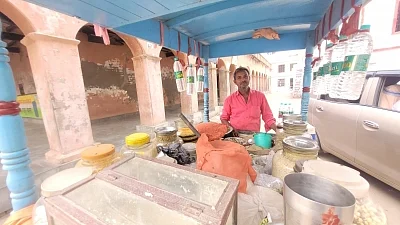"Bihar's Khajuraho", an exceptional instance of Nepali architecture, now the picture of neglect
While some play cards here on lazy afternoons, the homeless ones sleep on the premises at night. Seems not all Hindu heritage is worthy of govt protection

Bihar's 'Khajuraho', an example of Nepali architecture, is a picture of neglect today. With its glorious history, it is looking for people who can save and preserve its historical art.
While some play cards here on lazy afternoons, the homeless ones sleep on its campus in the night.
This Nepali temple, located at Kaunhara Ghat in Bihar's Hajipur, has been called a mini Khajuraho. Today, it is in a dilapidated condition due to lack of maintenance.
Earlier, a large number of tourists used to come from far-off places to visit the temple. Some tourists still visit the temple, but most of them return disappointed by its dilapidated state, with none of the solemnity and pomp that was its due.
This temple to Lord Shiva was built on Kaunhara Ghat at the confluence of the Ganga and the Gandak rivers in Hajipur.
The temple displays beautiful workmanship in wood, depicting different postures of kamkala (the arts of desire), which has given it the moniker of Bihar's Khajuraho. The entrance to this pagoda-style temple is also made of wood, with square-patterned lattices incorporated in it.
There is a shivling inside and 16 rectangular wooden panels. The lower part of the panels depict men and women in different postures of kamkala.
It is believed that the temple was built around 500 years ago. Today, its interior walls are visibly collapsing.
Youngsters have scribbled their own and their lovers' names on the walls of this historical monument, while some have written messages for their beloved to find. The priceless panels have now become food for wood termites.
B.K. Pandey, a retired professor, apprised this reporter that the historical temple was built by a commander of the Nepalese army in the 18th century, Matbar Singh Thapa. Since the temple was built by a Nepalese commander, locals also refer to it as a Nepali "cantonment".
Mahant Arjun Das of Kabir Math, located at Butan Das Ghat nearby, also spoke of the artistic merit of the wooden pillars supporting the four sides of the temple's central section. It has doors on all four sides.
Das added that though the shivling in the sanctum sanctorum of the temple remains, some idols were stolen in 2008.
He noted too the kamashastra (education on the arts of desire) depicted through different postures in the panels, and feels the temple has real historic and local importance.
Apart from an abundance of wooden strips, the temple also uses iron pillars, bricks and rocks in its construction. Pandey said that despite the lack of proper preservation, it is a priceless treasure and falls into the category of "protected monument".
The temple's caretaker, Vijay Shah, said that he has been looking after the temple but has not received a salary for years, which is why he is forced to sell chana (Bengal gram) on the streets for a living.
Shah added that they (the locals) explain the situation to the officials and leaders whenever they visit Hajipur, but to no avail—the powers that be do not seem interested in saving this historical heritage site.
Locals say that if the Nitish Kumar-led government in the state, which makes claims of preserving history, saved this temple, it could increase tourism and prove to be very advantageous.
The locals still hope that the government will someday take action in the matter and preserve the monument.
They also fear that the whole monument will just be confined to pages in the history books (if that!) if not revived soon.
Follow us on: Facebook, Twitter, Google News, Instagram
Join our official telegram channel (@nationalherald) and stay updated with the latest headlines
